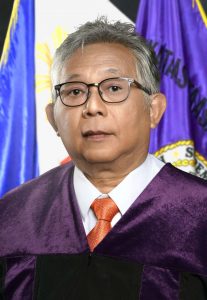Incumbent Justices

Justice Alfredo Benjamin S. Caguioa
Justice Alfredo Benjamin Sabater Caguioa is the 174th Associate Justice of the Supreme Court.
Prior to his appointment on January 22, 2016, Justice Caguioa began his government service in the Executive Department, serving as Secretary of the Department of Justice (DOJ) and Chief Presidential Legal Counsel (CPLC) to former President Benigno C. Aquino III.
As DOJ Secretary and Attorney-General of the government, Justice Caguioa rendered legal advice and opinions to government agencies and to government-owned and -controlled corporations. At the DOJ, he introduced reforms to streamline the agency’s operations and improve the quality of DOJ services to its stakeholders. He exercised supervision and control over the offices of the DOJ and exercised administrative supervision over DOJ-attached agencies such as the National Bureau of Investigation, Bureau of Immigration, Bureau of Corrections, Public Attorney’s Office, and Office of the Government Corporate Counsel. He also chaired the Inter-Agency Committee on Extra-Legal Killings, Enforced Disappearances, Torture and Other Grave Violations of the Right to Life, Liberty and Security of Persons as well as the Inter-Agency Council Against Trafficking.
As CPLC, Justice Caguioa rendered legal advice to the President on matters requiring Presidential action. He also advised the President on the legal aspects of national matters of high public interest and other policy concerns. He reviewed draft presidential and executive issuances emanating from the Office of the President and other executive agencies. He also reviewed decisions on administrative and criminal cases appealed to the Office of the President. As well, he reviewed government contracts requiring Presidential approval. He studied and made recommendations on legal issues brought to the attention of the President for the guidance of heads of departments, bureaus and offices in the Executive Branch. As CPLC, he served as a member of the Judicial Search Committee of the Office of the President that screens, evaluates and recommends to the President appointments to the Judiciary, National Labor Relations Commission and the Legal Education Board.
Prior to joining the government, Justice Caguioa had two and a half decades of experience in litigation and arbitration.
Justice Caguioa joined SyCip Salazar Hernandez & Gatmaitan (SyCip) in 1986 and was a partner there from 1994 until 2007. In SyCip, he successfully handled and tried a broad range of cases involving expropriation, conflicting mining and real property claims, infrastructure and engineering disputes, product liability and tort, debt recovery, medical malpractice, among others, representing or acting as principal counsel for foreign and local clients and corporations. He is experienced in commercial and arbitration cases with issues of corporate restructuring and rehabilitation, as well as intra-corporate and construction disputes.
In 1987, Justice Caguioa took a one-year leave from SyCip to practice with his father, the late Eduardo P. Caguioa, a retired Justice of the then Intermediate Appellate Court (now Court of Appeals) and a noted author on and professor of Civil Law. While with Justice Eduardo Caguioa, he handled mostly appeals to the Court of Appeals and the Supreme Court.
In February 2007, Justice Caguioa withdrew from SyCip and founded Caguioa & Gatmaytan Law Firm (CaGat). He was at the helm of this full-service firm from its inception until his appointment as CPLC in January 2013. In CaGat, he specialized in civil and commercial litigation before courts and quasi-judicial bodies of all levels, and arbitration before various arbitration bodies. He was cited as a leading Philippine lawyer in the Dispute Resolution field by Chambers & Partners in its 2010 and 2011 Asia-Pacific publications. He actively practiced before the different levels of the prosecutorial system, and had acted as both private prosecutor and defense counsel before the regular courts and the Sandiganbayan.
Justice Caguioa taught Obligations and Contracts, Property, Statutory Construction, and Administrative Law at the Colleges of Law of Ateneo de Manila University, University of Santo Tomas and San Sebastian College.
Justice Caguioa obtained his degree in Economics (Honors Program) from the College of Arts and Sciences of Ateneo de Manila University in 1981 (Honorable Mention), and graduated with honors from its College of Law in 1985, ranking fifth in his class. He was admitted to the Philippine Bar in 1986 after placing fifteenth in the 1985 Bar examinations. He is currently the Chairperson of the Sub-Committee on Integrated Bar of the Philippines (IBP) Oversight and a member of the Sub-Committee for the Revision of the 1997 Rules of Civil Procedure.
Email Us
Please include your name, contact number, email address, and the subject in your email.
Please read our Privacy Notice for the terms on the collection of your personal information.
By using this Query Form, you agree to the collection of personal data. For more information, you may refer to our Privacy Notice.












